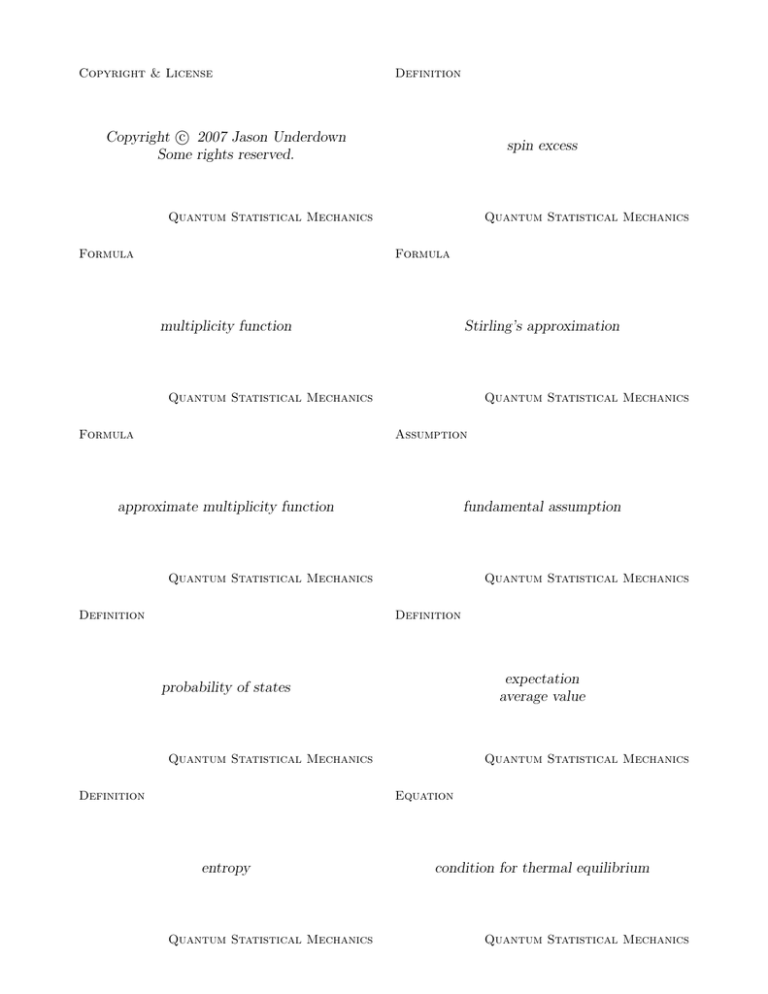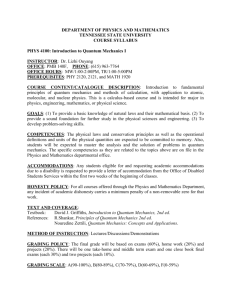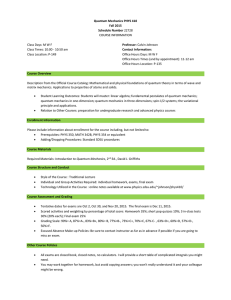
Copyright & License
Definition
c 2007 Jason Underdown
Copyright Some rights reserved.
spin excess
Quantum Statistical Mechanics
Formula
Quantum Statistical Mechanics
Formula
multiplicity function
Stirling’s approximation
Quantum Statistical Mechanics
Formula
Quantum Statistical Mechanics
Assumption
approximate multiplicity function
fundamental assumption
Quantum Statistical Mechanics
Definition
Quantum Statistical Mechanics
Definition
expectation
average value
probability of states
Quantum Statistical Mechanics
Definition
Quantum Statistical Mechanics
Equation
entropy
Quantum Statistical Mechanics
condition for thermal equilibrium
Quantum Statistical Mechanics
Assuming N is even, then we define the spin excess by
N↑ − N↓ = 2s
These flashcards and the accompanying LATEX source
code are licensed under a Creative Commons
Attribution–NonCommercial–ShareAlike 2.5 License.
For more information, see creativecommons.org. You
can contact the author at:
jasonu [remove-this] at physics dot utah dot edu
N ! ≈ (2πN )1/2 N N exp(−N + (1/12)N + · · · )
The fundamental assumption of statistical mechanics
is that in a closed system, each of its accessible states
is equally likely.
Suppose that a system has some physical property
X = X(s) when the system is in state s. The expected
or average value of X is defined by:
X
hXi =
X(s)P (s)
s
g(N, s) =
1
2N
N!
N!
=
N↑ ! N↓ !
+ s ! 21 N − s !
G(N, s) ≈ (2/πN )1/2 2N exp(−2s2 /N )
If s is a state of a system, then the probability of that
state is given by:
1/g if s is an accessible state
P (s) =
0
otherwise
The sum of the probabilities over all states is unity.
X
P (s) = 1
s
If two systems are in thermal contact, the condition
for them to be in thermal equilibrium is the following:
∂σ1
∂σ2
=
∂U1 N1
∂U1 N2
σ(N, U ) ≡ ln g(N, U )
Definition
Definition
fundamental temperature
Kelvin temperature
Boltzmann constant
relationship between entropy
and classical thermodynamic entropy
Quantum Statistical Mechanics
Equation
Quantum Statistical Mechanics
Equation
multiplicity function for the Hydrogen atom
multiplicity function for 3D harmonic
oscillator
Quantum Statistical Mechanics
Quantum Statistical Mechanics
Quantum Statistical Mechanics
Quantum Statistical Mechanics
Quantum Statistical Mechanics
Quantum Statistical Mechanics
Quantum Statistical Mechanics
Quantum Statistical Mechanics
1
=
T
∂S
∂U
1
≡
τ
∂σ
∂U
N
N
τ = kB T
S = kB σ
kB = 1.381 × 10−23 J/K
The multiplicity function for a simple harmonic oscillator with three degrees of freedom with energy En is
given by
1
g(n) = (n + 1)(n + 2)
2
where n = nx + ny + nz .
The multiplicity function for a Hydrogen atom with
energy En , is given by
g(n) =
n−1
X
(2l + 1) = n2
l=0
where n is the principal quantum number, and l is the
orbital quantum number.







